In early spring, pockets of snow shelter in the shadowed crevices of the high sierra.
Brisk breezes, still carrying a tinge of winter’s chill, bend the boughs of mighty
pine trees and spread their fragrance throughout the forests of Madera.
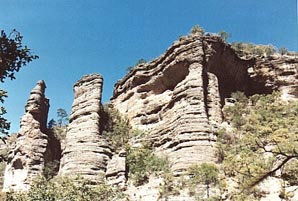 |
Arroyo de Garabato |
To the north of
town, at the narrow chasm of Arroyo de Garabato, the sun casts its first light on
streaked, salmon-colored cliffs that plunge to the river below. Here, the cave dwellings
of Cuarenta Casas are tucked into the rocky overhangs of these massive walls. The Cuarenta
Casas archaeolgical site is the most well known and accessible of the cave and cliff
dwellings in northern Mexico. No one is sure why they were built but their location high
above the river with an encompassing view of both the sierra and the canyon suggests that
they may have been guard posts along an old trade route that linked Paquime with the
Pacific coast.
The great Paquime culture flourished as the main trade and ceremonial center of
northern Mexico around 1300 AD. Its trade routes extended to the Pacific, the Gulf of
Mexico and to other cultural centers to the north such as Mesa Verde in Colorado and Chaco
Canyon in New Mexico. The routes to the Pacific followed the Piedras Verdes River to the
south and connected with the rivers that flow to the Pacific by way of smaller arroyos and
canyons. Among these is the Huapoca Canyon to the west of the town of Madera. The Huapoca
Canyon is not among the deepest of the Sierra Tarahumara but it possesses the most
archaeological interest.
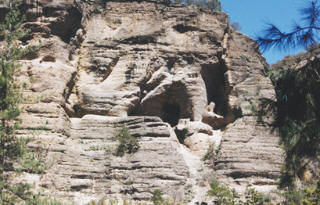 |
Cave Dwellings at Cuarenta Casas |
There are five main cave communities near Madera. To the north are Cuarenta Casas
and Cueva del Puente. At the beginning of the 16th century,
explorer Alvar Nunez Cabeza wrote, "…and here by the side of the mountain, we
forged our way inland more than 50 leagues and there found forty houses (cuarenta
casas)…" It is not certain if there were actually forty houses as fewer remain
today. They can be viewed across the chasm from the visitor’s hut and are not
accessible to the public except for Cueva de las Ventanas which has some 1000 year
old Paquime-style adobe dwellings with characteristic T-shaped doorways and stucco floors.
Cueva de las Ventanas is larger than Cueva del Puente and they both require about an
hour’s hike one way along steep but well maintained paths.
Directly to the west of Madera are the Anasazi caves and Cueva Grande.
Although they are fairly close on a map, poor roads and unkept trails make it difficult to
visit both sites on a one day trip. There are supposed to be guides available but this is
not always the case so it is best for visitors to be accompanied by someone who knows the
way. The Anasazi caves consist of the Cueva de la Serpiente and Nido del Aguila. Cueva de
la Serpiente is the larger of the two with 14 adobe dwellings that are over a thousand
years old. Nido del Aguila has only one dwelling that clings precariously to the edge of a
sheer cliff under a rocky overhang that gives meaning to its name, the Eagle’s Nest.
The Anasazi caves are considered by some to be the most impressive of the cliff dwellings.
This is due to the well preserved structures, the integrity of the site itself which has
not been as vandalized as other sites and the magnificent views high above the broad
expanse of the Huapoca Canyon.
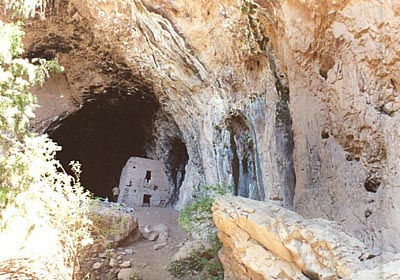 |
Cueva Grande |
Across from the Anasazi caves, the descent from the sierra to the barranca is more
gradual. Cueva Grande lies hidden within the convoluted folds
of the land and is embraced by the branches of tall trees. The mouth of the cave is
further obscured by a waterfall that cascades off the top of the cave to a pool and stream
below. Even in drier months when the little waterfall is reduced to a trickle, the fine
mist of water captures the sunlight to paint a delicate, shimmery rainbow. Its beauty,
seclusion and constant water supply must have been idyllic to the people who lived in this
parched, rugged terrain. A path rises from the pool to the cave’s entrance just
behind the waterfall. There are two 800 year old, two-story dwellings that provide good
examples of the construction techniques of that time. There is also a round grain storage
area behind the structure closest to the mouth of the cave.
The road forks just before crossing the suspension bridge at the bottom of the Huapoca
Canyon on the way to Cueva Grande. The left fork descends to Agua Caliente de Huapoca, a
small thermal spring on the river bank. Its warm waters flow to a little soaking pool and
continues on to the river where there is a natural swimming hole. Agua Caliente de Huapoca
is reputed to cure a variety of ailments but it is perfect for sore feet after walking
along the uneven trail to Cueva Grande.
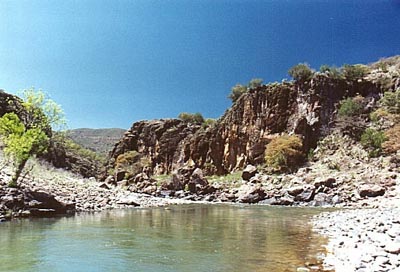 |
Huapoca Canyon |
It is difficult to find a taxi driver to make the trip to La Rancheria where
there are some fine ruins that cover an extensive area at the base of the Sirupa Canyon.
Located 50 Km south of Madera (a two hour drive one way), there is a lengthy walk (another
two hours each way) along a rough trail. A daytrip to La Rancheria requires a minimum of 9
to 10 hours with relatively little time to explore. The Sirupa Canyon is better visited on
an overnight trip which also allows time to visit the site of the old San Andres de Sirupa
Mission. It was destroyed during the Tarahumara uprising of 1690 and all that remains is
the shell of a hacienda that was constructed there in 1830. However, the surrounding
landscape is particularly beautiful and makes the half hour trip from the village of
Sirupa worthwhile. Nearby, the thermal springs of Agua Caliente de Sirupa gush from the
Sirupa River bank that is a good spot for camping.
Best Times to Go:
Spring and fall have the best balance of cool sierras and warm
barrancas. The beginning of fall is especially beautiful when the poplars and alders of
Madera begin to change color.
Getting There:
Madera possesses a basic tourist infrastructure and is the closest
town to the archaeological sites. It is reached from the nearby cities of Nuevo Casas
Grandes, Cuauhtemoc and Chihuahua by local bus. See the ‘Getting There’ section
of the Sierra Tarahumara for general information about traveling to the Copper Canyon
region from Mexican and US cities.
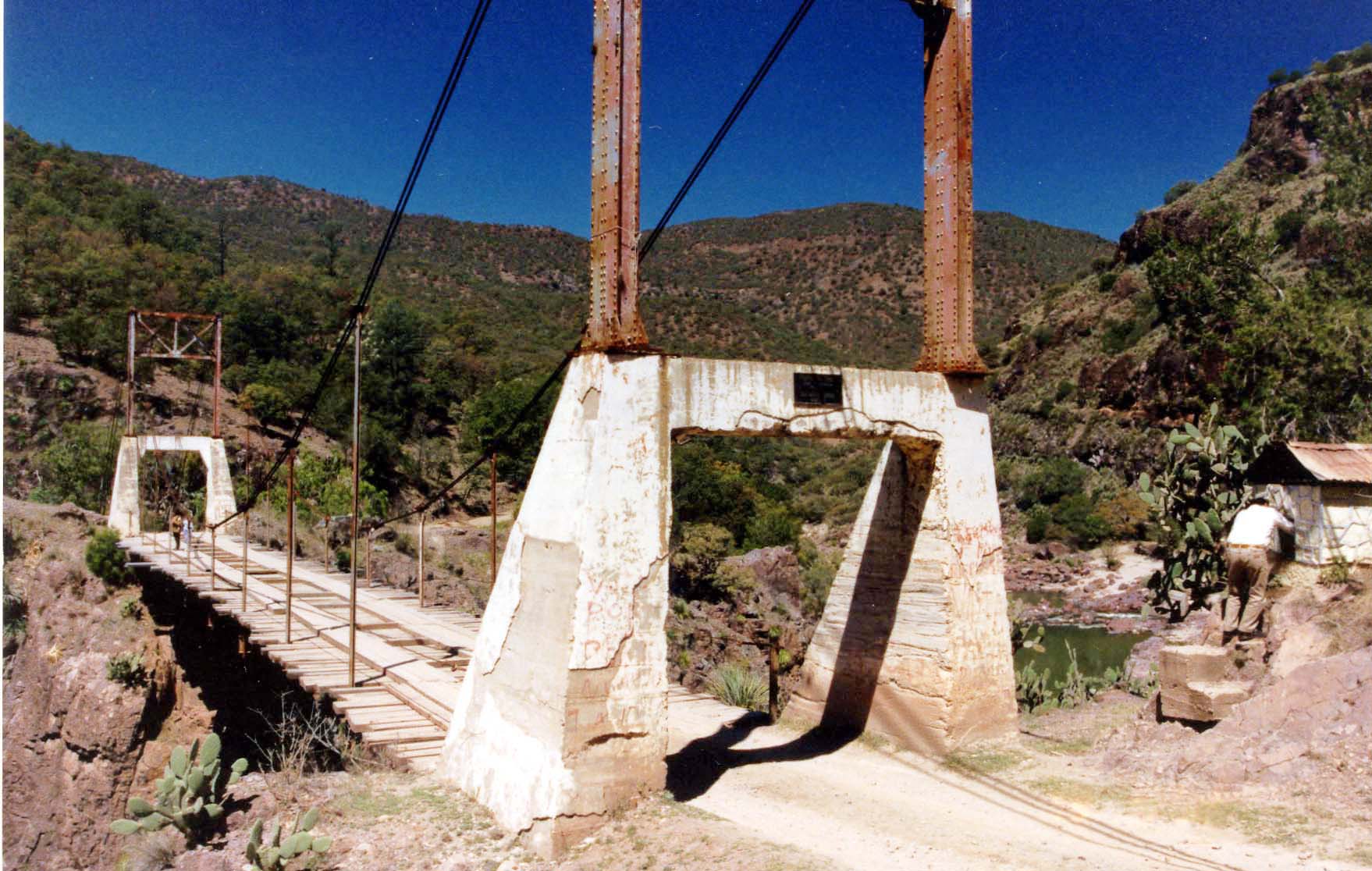 |
Huapoca Suspension Bridge |
By car, Madera is located to the south of Nuevo Casas Grandes and to the northwest of
Chihuahua. There are two main routes from Ciudad Juarez. The longer but more interesting
route follows Highway 2 westward to Janos then south to Nuevo Casas Grandes and
Buenaventura. Take Route 28 to Gomez Farias and about 11 Km out of town, watch the signs
for the turnoff to Madera. The distance from Ciudad Juarez to Madera by this route is
about 540 Km. The other is to take the toll road to Chihuahua. Exit at El Sueco and travel
to Buenaventura where Route 28 leads to Gomez Farias and Madera. This route from Ciudad
Juarez to Madera is approximately 490 Km.
From Chihuahua, take the Cuauhtemoc toll road (Highway 16) for 101 Km to Cuauhtemoc and
continue along Highway 16 to La Junta. Follow the signs to Guerrero, Matachi, Temosachi
and on to Madera. The total distance from Chihuahua to Madera is about 285 Km.
To visit the ruins, a good road leads to the Cuarenta Casas site and Cueva del Puente
approximately 45 Km to the north of Madera. Cueva Grande (66 Km) and the Anasazi caves (33
Km) are reached along a dirt road to the west from the roundabout at the entrance to
Madera. Along this road just out of town, is the turnoff to the Sirupa Canyon region where
the caves of the La Rancheria complex (50 Km) are located.
Clothing/Gear:
Substantial walking is required to visit the cave dwellings. Hiking
boots are preferable for steep paths and loose scree especially in the rainy, summer
months. Clothing should be comfortable and season appropriate. Remember that the sierras
are cooler than the barrancas and even in summer months, a light jacket is needed. A
flashlight is helpful for exploring the interior of the dwellings as well as the recesses
of some caves. Within the canyons, bring a swimsuit and towel to take advantage of the
refreshing rivers and thermal springs. All food and water must be carried into the canyon
as no supplies are available outside of Madera.
General Information:
Five main cave complexes are spread along the length of the
Huapoca Canyon and its side canyons and arroyos. The distance between the sites, poor
roads and the necessity of a one to two hour walk to each site makes it impractical to
visit more than one complex in the course of a single day. An exception is the Cuarenta
Casas site which can be combined with the Cueva del Puente. Both are located along the
same paved road but an early start is recommended due to the requisite hike to the sites
and back.
The best way to explore the Huapoca Canyon is by private 4WD vehicle with the option of
camping when convenient. However, most visitors must make do with the limited tourist
infrastructure of the region. Using Madera as a base, day trips can be undertaken to the
cave dwellings. Tours are offered by the Motel Real del Bosque for groups of 4 to 6
depending on the destination. A more convenient alternative is to negotiate your own tour
with a local taxi driver. The cost will vary but approximately $20 - $25 per hour is a
reasonable rate.
The few hotels in Madera are more expensive than comparable hotels in Creel. The Motel
Real del Bosque, located at the entrance to town, is considered to be the best hotel
available and it has a good adjoining restaurant. Travelers arriving by bus may find the
Parador de la Sierra and Motel Maria to be more convenient as they are located within
walking distance of the bus station and other restaurants. Their facilities are not modern
but rooms are clean with private bathrooms and hot water. Nearby grocery stores have a
good variety of canned and fresh foods for picnic lunches and to supplement the mostly
fried meals available in the restaurants.
Planning Tips:
- Consider including a trip to Paquime when visiting the Huapoca Canyon. Their related
history will make this journey more interesting.
- Don’t try to incorporate all the canyons into a single Copper Canyon adventure.
Each canyon is unique and should be explored leisurely. The Huapoca Canyon offers the best
examples of thousand year old Paquime-style cliff and cave dwellings.
- The tourist infrastructure of this region is limited and there are no
luxury accommodations available.
- Don’t wander off the paths to the archaeological sites. The terrain is very rough
and it would be unlikely to find help should you need it. Also, drug cultivators may
occupy the barrancas of the remote Huapoca Canyon.
- Don’t assume that it is easy to get from one place to another because they appear
to be close on a map.
- Take all your food and water requirements when entering the canyon as few provisions
are available outside of Madera.
Important Resources:
- Motel Real del Bosque
Carretera Chihuahua-Madera Barrio Americano Madera
Madera Chihuahua, Mexico
Tel: 52-652-572-0066
Fax: 52-652-572-0538
Motel Real del Bosque has the best accommodations in Madera. Consequently, it is
frequented by tour buses and advanced reservations are highly recommended. It is the only
motel in town that offers organized tours of the surrounding countryside including the
archaeological sites. Tours require a minimum of 4-6 people depending on the destination.
Related Books:
- Northern Mexico Handbook
by Joe Cummings has very good overall information about
the Paquime culture and the archaeological sites of the Huapoca Canyon.
- 2001 Mexico and Central America Handbook
by Peter Hutchison is
published by Footprint Books in the UK and Passport Books in the US. There is a good
section about Madera and the archaeological sites of the Huapoca Canyon. It also has the
most current information about available accommodations in Madera.

Adventures Great and Small © copyright 1996-2005







